August was slightly cooler and much drier than average across Illinois. The preliminary statewide average August temperature was 72.7 degrees, 0.9 degrees below the 30-year normal and the 45th coolest on record. Preliminary statewide average total precipitation for August was 2.01 inches, 1.58 inches below than the 30-year normal and the 15th driest on record.
Data are provisional and may change slightly over time
August Temperatures
Following the warmer than average months of June and July, August began much cooler than average. The below average temperatures persisted through the third week of the month in response to a persistent atmospheric trough over the central U.S. The map below shows temperatures were between 1 and 4 degrees below average through the first three weeks of August.
Between August 1 and 21, 43 daily low maximum temperature and 6 daily low minimum temperature records were broken across the state. This included a 70-degree high temperature in Salem in Marion County, which broke the previous record by 10 degrees.
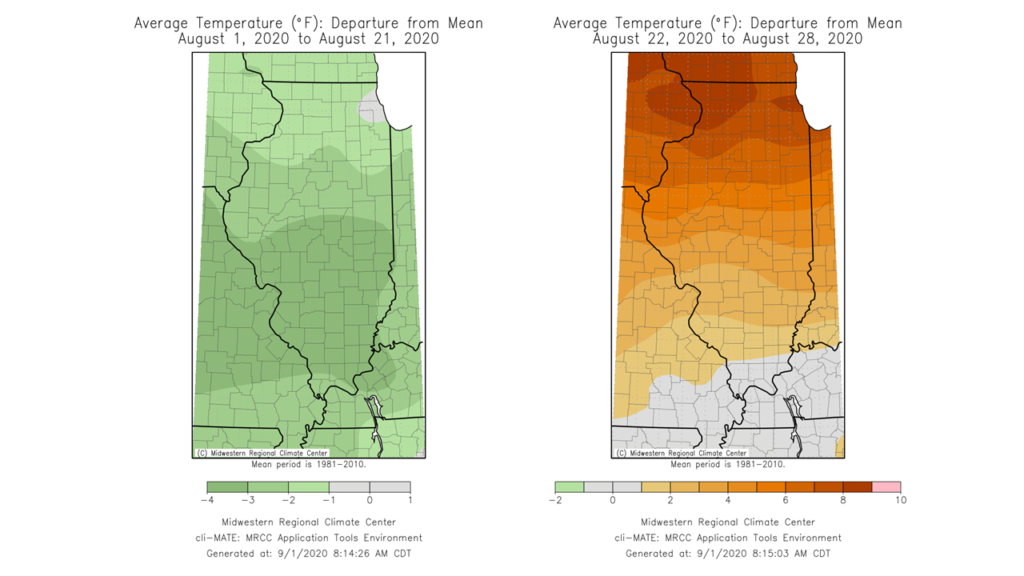
As the ridge in the western U.S. broke down in the third week of August, heat spread east, and Illinois temperatures switched to considerably above average. As the map below shows, temperatures in the week of August 22 were 1 to 10 degrees above average with the highest departures in northern Illinois.
During this fourth week of August, 10 daily high maximum temperature and 6 daily high minimum temperature records were broken. Mount Carroll in Carroll County broke or tied their daily high maximum temperature records on three consecutive days between August 25 and 27. Most stations observed daily high temperatures in the 90s this week, including five consecutive 90+-degree days in Rockford. This was the longest such streak in Rockford in August since 2011. The station at Chicago’s O’Hare Airport observed 10 days with a high temperature at or above 90 degrees last month. This is tied for the sixth most 90+-degree days at O’Hare, going back to 1959, and the most since 2012. The climatological average August frequency of 90+-degree days at O’Hare is 4. This is compared to the station in Carbondale that typically experiences 11 90+-degree days in August, but only observed 4 this last month.
Although the fourth week of August was unusually warm in northern Illinois, temperatures were closer to average in southern Illinois. The plot below shows daily temperature departures in Rosiclare in Hardin County. The southeast Illinois climate division, containing Rosiclare, experienced its eighth coolest August on record.
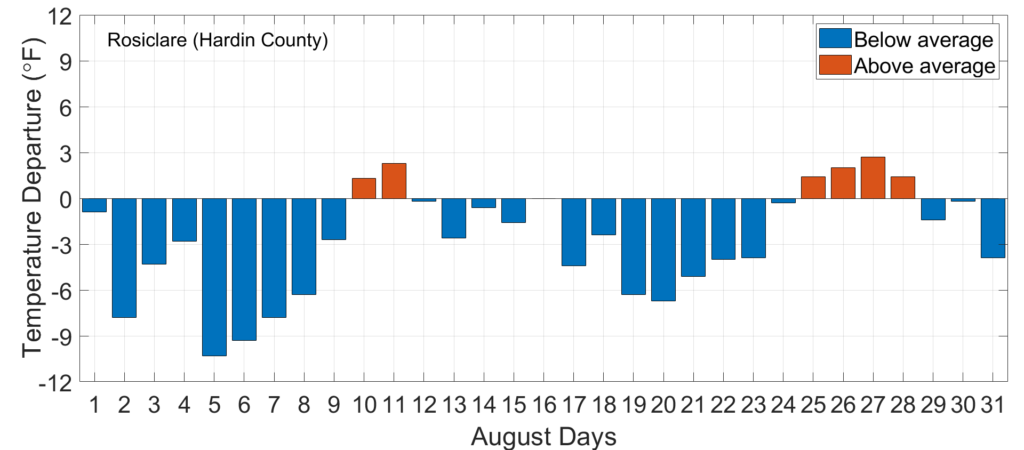
The statewide August temperature was 72.7 degrees, nearly 1 degree below the 30-year normal. The maps below show that average temperatures were in the mid- to high 70s across the state last month, very close to the long-term average in northern Illinois, and between 1 and 4 degrees below average in southern Illinois.
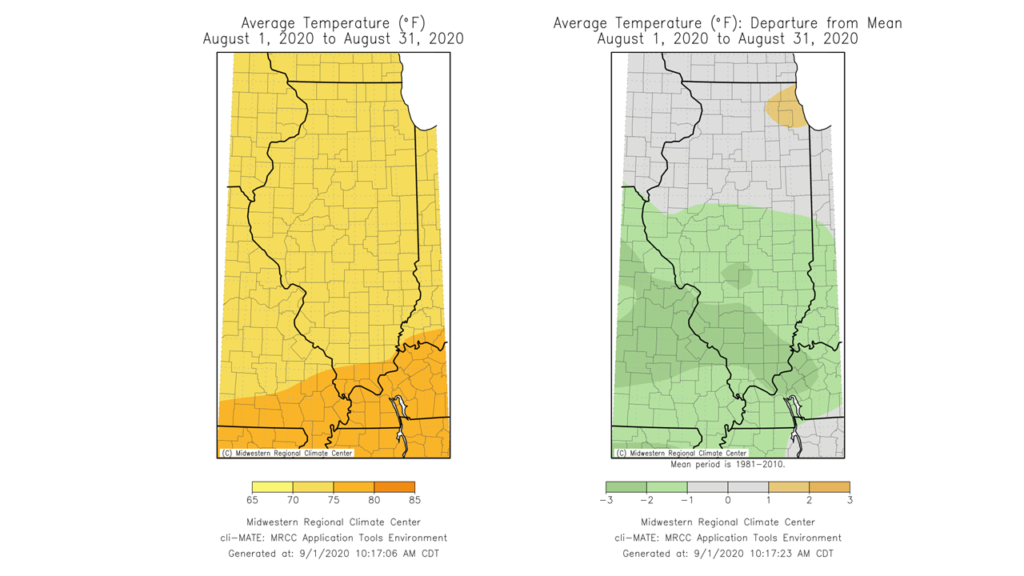
The maps below show the climatological summer (June–August) 2020 maximum, average, and minimum temperature departures from average. June and July this year were both in the top 30 warmest months on record, resulting in an overall warmer than average summer in northern Illinois. However, the cooler August pushed summer temperatures within a degree of the long-term average in most of southern and south-central Illinois.
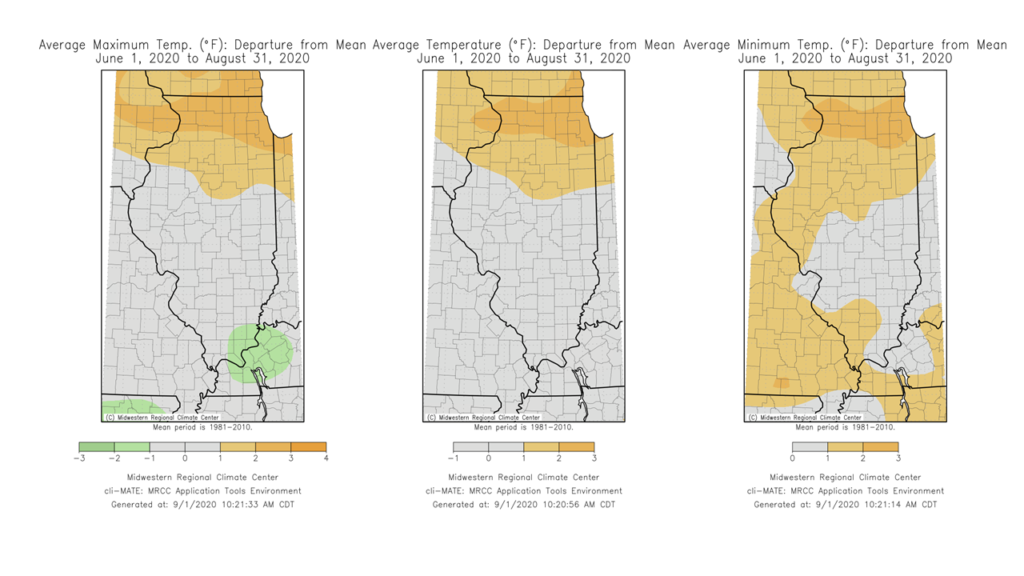
August Derecho
August was not without its fair share of severe weather. On August 10, a strong mesoscale convective system moved across the Upper Midwest. The system intensified in the eastern Dakotas and caused a derecho–a widespread, long-lived windstorm–that impacted areas of Iowa, Illinois, Wisconsin, and Indiana. A derecho is characterized by strong straight-line winds that can exceed 75 mph and often affect areas between 250 and 500 miles. Dr. Marshall Shepherd at the University of Georgia provides an excellent description in his piece in Forbes: https://www.forbes.com/sites/marshallshepherd/2020/08/10/what-is-a-derecho/#44cb250c3b8e.
The derecho on August 10 produced observed winds exceeding 100 mph and estimated (from damage) wind gusts up to 140 mph across east-central Iowa. Based on initial reports, the derecho damaged between 6 and 10 million acres of crops across Iowa and northern Illinois. In addition, the winds caused significant damage and destruction in residential and urban areas. The city of Cedar Rapids, Iowa was hit particularly hard. The local newspaper reported estimates of over 20,000 trees downed in Cedar Rapids alone (https://www.thegazette.com/subject/news/derecho-by-the-digits-numbers-help-tell-the-story-of-the-storm-20200830), causing hundreds of thousands to lose power and remain without power for several days. The storm also resulted in four fatalities, three in Iowa and one in Indiana.
Along with the derecho, the storm produced 15 confirmed tornadoes in the Chicagoland area. The figure below is from the Chicago National Weather Service, showing the tracks of these tornadoes, including a couple that moved through the city of Chicago.
More research is necessary to better understand the environment that produces a derecho, and the corresponding warning of these events and risks they pose. One paper by Guastini and Bosart in Monthly Weather Review (https://journals.ametsoc.org/mwr/article/144/4/1363/72372) found northern Illinois experiences a derecho once every two years. However, not all derecho events are as large, long-lived, and intense as the event earlier last month.
Southern Illinois Remains Wet
Statewide August total precipitation was 2.01 inches, 1.58 inches below the 30-year normal and the 15th driest on record. However, like the varying temperatures, the southern and northern halves of the state experienced two very different August precipitation patterns. The maps below show August total precipitation and departures from average across the state. August totals ranged from less than a quarter of an inch in northwest Illinois to over 8 inches in southwest Illinois. In general, the northern half of the state experienced 1 to 4 inches below average, while most of southern Illinois experienced a 1 to 3 inches above average rainfall last month.
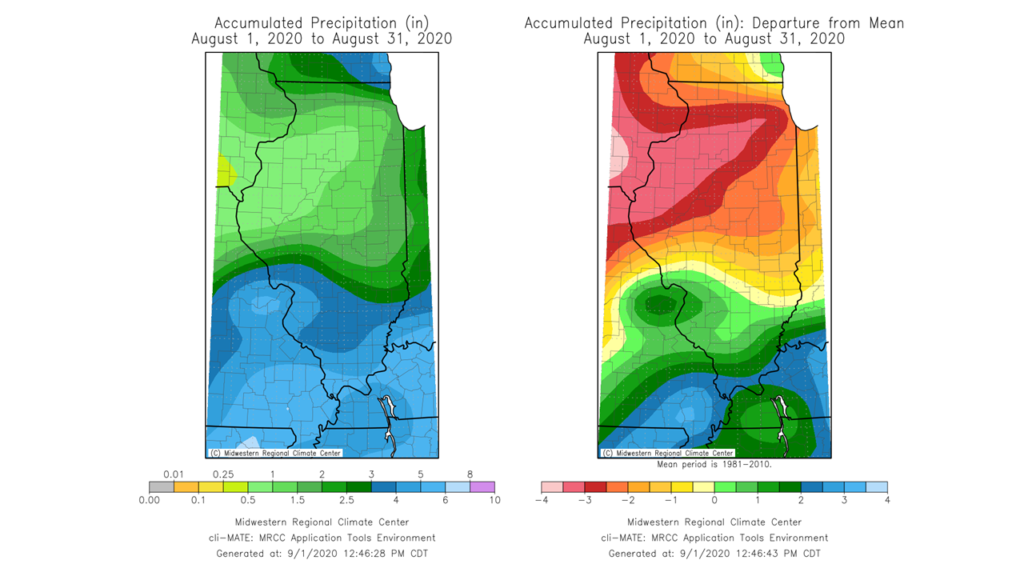
We can contrast the two halves of the state by comparing total rainfall in the Quad Cites with that in the St. Louis Metro East. The station at the Quad Cities Airport in Moline observed just 0.15 inches of total rain in August, which was less than half the previous low August total record of 0.35 inches in 1971 (see plot below).
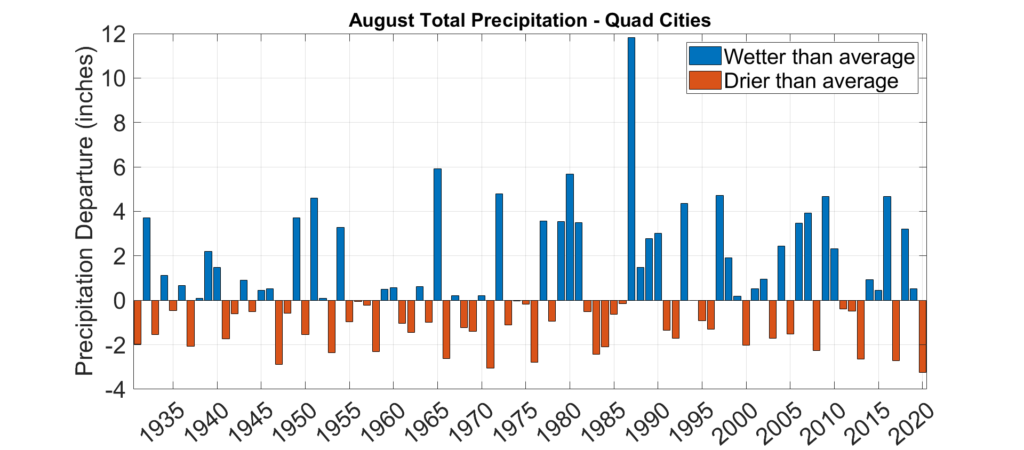
As the Quad Cities experienced their driest August on record, the station at the SIU Research Farm in Belleville observed their wettest at over 10 inches of total rainfall last month. Of particular note was a strong thunderstorm that moved through the St. Louis area on August 12, producing heavy rainfall for the Metro East area. The station at Scott Air Force Base near Belleville recorded 5.36 inches in only three hours from this storm. The heavy rain produced flash flooding across the area, including multiple hangars on the base that were flooded. According to new estimates from the Illinois State Water Survey’s Bulletin 75 (https://www.ideals.illinois.edu/handle/2142/106653), this was approximately a 125-year rainfall event.
Northern Illinois Drought
July was slightly drier than average across most of northern Illinois. The first week of August was somewhat wet across the state; however, for most areas of northern and central Illinois, more rain fell in the first week of August than in the last three weeks of the month. The rainfall deficit was somewhat offset by below average temperatures during the first few weeks of the month. However, as heat began to set in and the northern half of the state experienced multiple, consecutive 90-degree days, the lack of moisture became quite apparent.
The plot below shows the daily accumulated difference between precipitation and reference evapotranspiration–an indicator of atmospheric evaporative demand–at the Illinois Climate Network Monmouth station. Looking at dry conditions through this lens provides a water balance perspective. The Monmouth record shows a positive water balance at the beginning of the month due to precipitation. However, the subsequent lack of rainfall after August 5 results in a negative water balance that is accelerated in the final weeks of the month. The station in Monmouth ended the month with an over 4-inch moisture deficit.
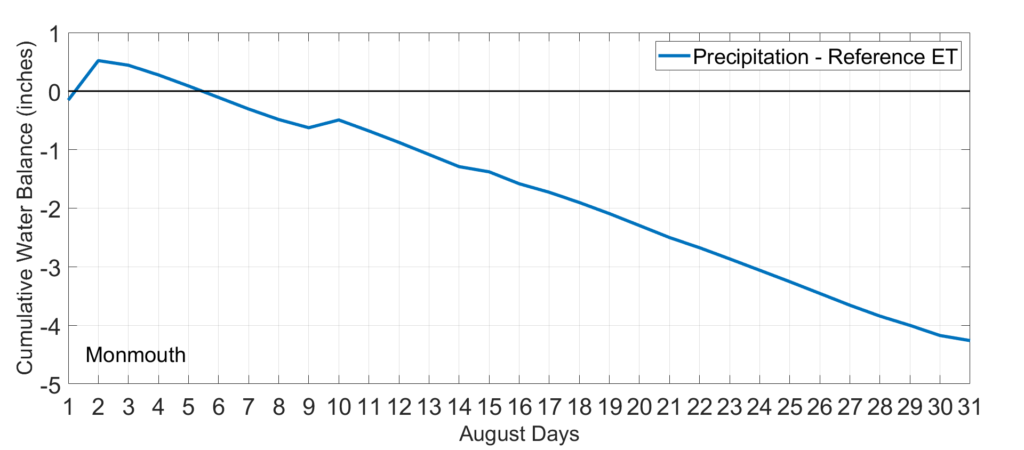
In response to pervasive dry conditions in northern Illinois, most of the area is considered abnormally dry in the August 25 edition of the U.S. Drought Monitor (below). There are also pockets of moderate drought in western and northeast Illinois in response to agricultural and ecological impacts of the dryness.
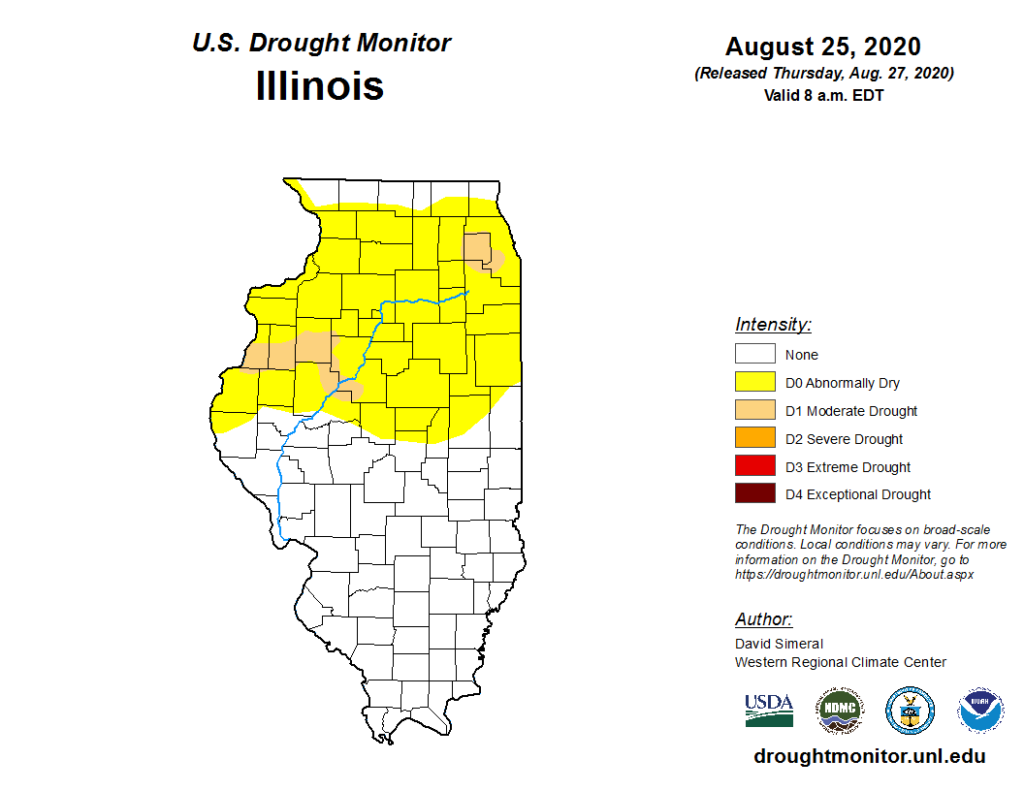
Climatological summer (June–August) precipitation patterns are like those in August, with contrasting conditions in northern and southern Illinois. The northern half of the state finished summer with between 1 and 4 inches below average precipitation, while southern Illinois was 1 to 6 inches wetter than average this last season. The official summer season rankings will be released later this month, but it is worth mentioning that statewide total summer precipitation has only been below the 30-year normal 3 out of the last 10 years (2017, 2013, and 2012).
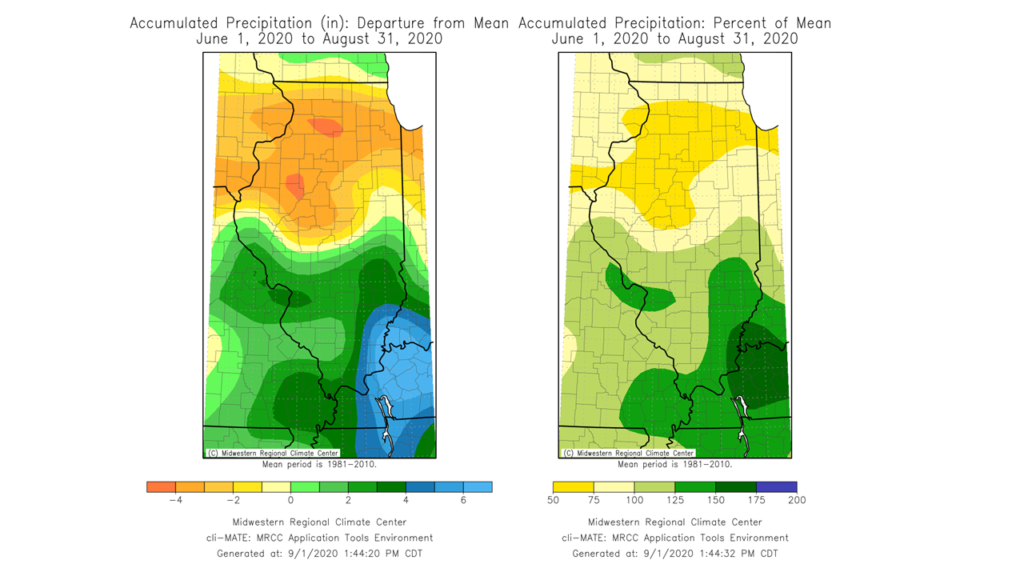
Outlooks
The late August heat will likely be replaced by cooler than average conditions throughout September. The Climate Prediction Center’s 8- to 14-day outlook and 1-month outlook both indicate strongly elevated odds of below normal temperatures.
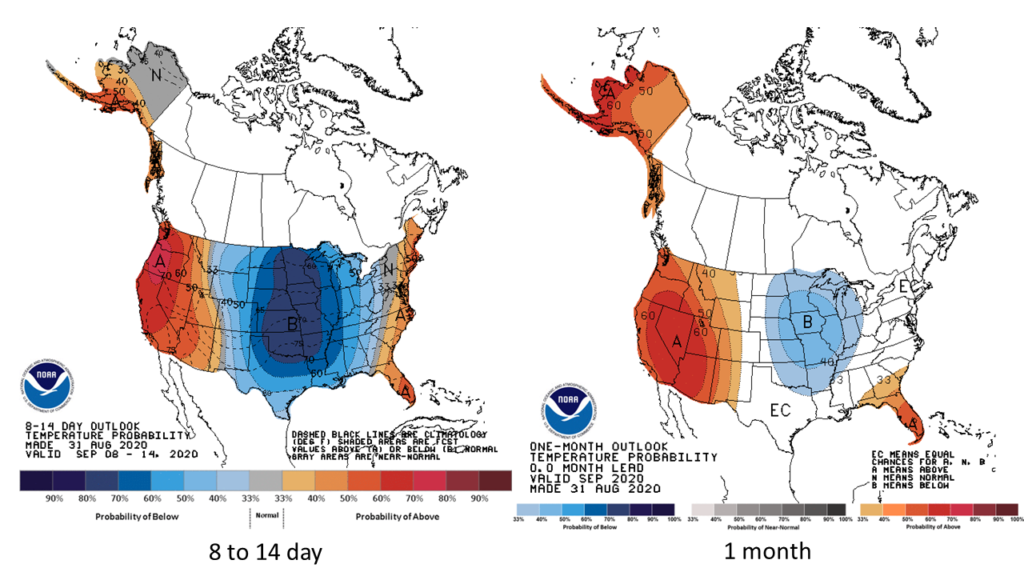
Precipitation outlooks are mixed. The 8- to 14-day outlook indicates weakly elevated odds of wetter than normal conditions in the eastern half of the state to start September, with near normal precipitation elsewhere. The one-month September outlook indicates weakly elevated odds of drier than normal conditions in northern Illinois, but equal odds of above and below normal precipitation elsewhere.
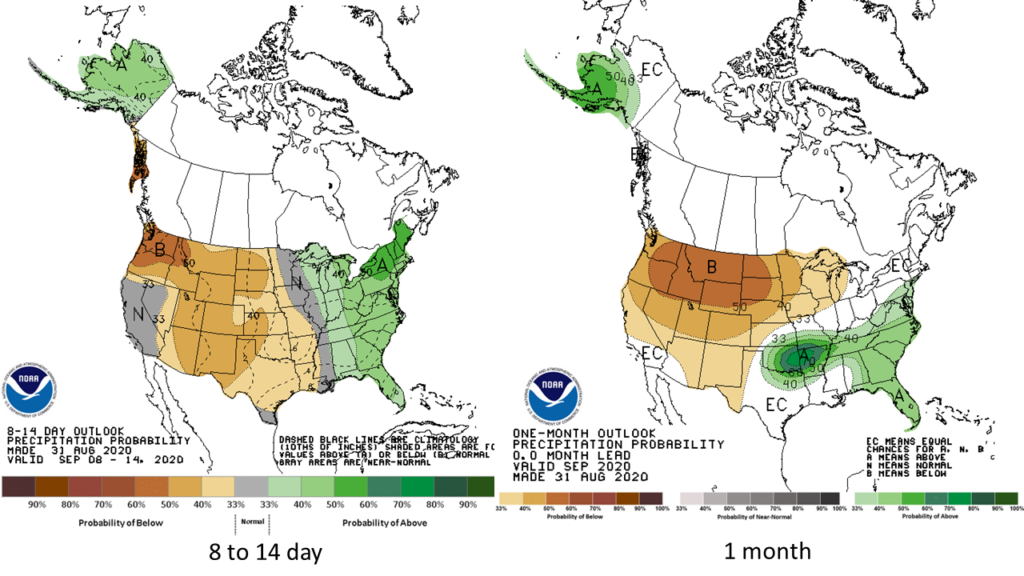
Cooler weather in September will help to temper ongoing drought in northern and central Illinois. However, September is one of the drier months in Illinois, and given the outlooks, it is unlikely that dry conditions will be completely alleviated.

